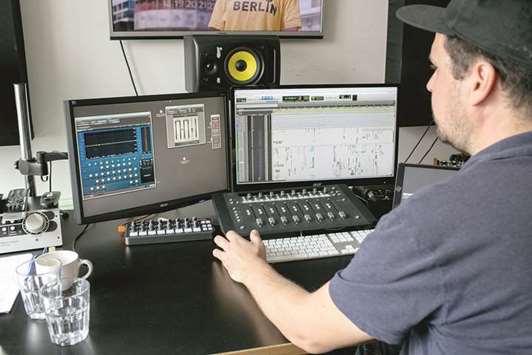How does dry ice scraped across metal sound? Paul Rischer knows. The 37-year-old is a sound designer and he – or rather, his computer – is chock full of all kinds of sounds that he can tap in order to provide acoustic effects for films.
“George Lucas once said that sound is 50 per cent of the film experience,” says Rischer, referring to the US director behind the famed Star Wars and Indiana Jones films.
Whether a scene succeeds in being dramatic or harsh, soft or sad – it all depends on the sound.
Once a completed film is sent to him, Rischer can spend up to two months in his studio adding sound effects for each and every moment.
“When a scene in, say, a discotheque is filmed, it is completely quiet on the set,” he says. “For the music and the background sounds, that’s where I come in.”
Rischer is convinced that sound is really all about stirring emotion. Whether an action film, a scary horror film or a romantic comedy, the sound designer has to have the acoustics to match every mood.
Sound designers don’t have to know how to play a musical instrument – though it helps – but they do have to have an ear for the right mix.
“As a rule, your instrument is your computer,” says Joerg Remy, an audio design professor at the College of Popular Arts in Berlin.
But audio design is not limited just to the film industry; the range of work is broad, be it coming up with a new ringtone or mixing together sounds for computer games. That’s not to mention all the sound needed in the advertising business.
Remy, 53, knows his way around in all this. A schooled concert guitarist, his repertoire ranges from Johann Sebastian Bach to Mercedes-Benz, and he has recorded classical music CDs as well as produced trailers for television spots.
Besides his musical compositions, he also is a specialist in “sound logos” – the specific sound theme that companies want customers to immediately associate with their products, Remy says.
Just as varied as the sounds that they create and work with are the ways that sound or audio designers come to their profession.
Some might have trained at a film academy, others started as musicians, and still others come from the electronic music scene.
At Remy’s college in Berlin-Babelsberg, applicants have to perform two of their own works. He says that he makes two things clear to them: “We’re not training DJs here, and we are not ‘Germany Is Looking for a Superstar.’ “
After getting their degrees, audio designers quite often work alone in their own studios as freelancers. However, teamwork and working with others is still part of the job, for example collaborating with the music composer on a film soundtrack. And be it a film or an advertising spot, the audio designer must be in tune with the wishes of the director or the marketing manager.
A good sound designer can master a wide variety of effects and has a feeling for the texture of sounds. Remy says that knowing the specific sounds of different instruments is also key.
“A piccolo flute naturally creates a different effect than, say, a distorted electric guitar,” he says.
And then there is the audio designer’s “toolbox” – the computer in which all the sounds and sound effects are archived and ready to use at the click of a mouse. What kind of sounds? Footsteps on a wooden floor. Wind. Urban noise. Or dry ice scraping on metal.
Asked how this last one sounds, Rischer types something into his computer, and a tinny, buzzing noise, slightly scratchy, comes from the speakers. Maybe the sound a UFO makes when landing in a sci-fi.
Then Rischer shows off his latest creation, a film about a bear on the loose in Berlin. It roars so powerfully that a home cinema subwoofer would vibrate uncontrollably. And how did he create this roar? Rischer admits to a bit of trickery – he crafted a sound mix from two animals. “It was actually a walrus and a bear,” he says. -DPA

Audio designer Paul Rischer shows off his main instrument u2013 his computer. Sound designers don’t have to know how to play a musical instrument but they do have to have an ear for the right mix.
